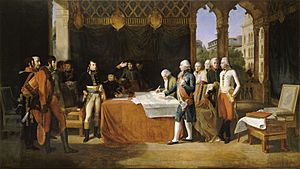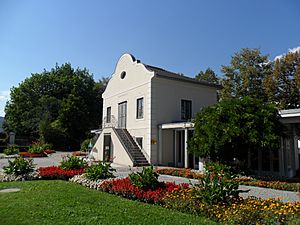Peace of Leoben facts for kids

A sketch of the signing, for a painting drawn in 1806 by Guillaume Guillon-Lethière. Now in the Palace of Versailles.
|
|
| Type | Armistice |
|---|---|
| Signed | 18 April 1797 |
| Location | Leoben |
The Peace of Leoben was an important agreement that temporarily stopped the fighting between the Holy Roman Empire (which was mostly Austria) and the First French Republic (France). It was a first step towards ending the War of the First Coalition, a big conflict in Europe.
This agreement was signed in a garden house near Leoben, a town in Austria, on April 18, 1797. The main people involved were General Napoléon Bonaparte for France and representatives of Emperor Francis II for the Holy Roman Empire.
Contents
What Was the Peace of Leoben?
The Peace of Leoben was an armistice, which means a ceasefire or a temporary stop to fighting. It was also a "preliminary peace agreement," meaning it was a first draft of a peace treaty. It aimed to bring an end to the War of the First Coalition, a major war that had been going on for several years.
The agreement was officially confirmed in Montebello on May 24, 1797, and it started right away.
How the Peace Talks Started
The idea for a ceasefire came from Napoléon Bonaparte. On March 31, 1797, he sent a letter to the Austrian commander, Archduke Charles. Napoleon wanted to stop the fighting and prevent more lives from being lost.
At first, there was no reply. So, the French army kept moving forward. By April 7, they had reached a town called Judenburg. That night, Archduke Charles offered a five-day truce, which Napoleon accepted.
On April 13, an Austrian representative named Merveldt went to Napoleon's headquarters in Leoben. He asked for the truce to be made longer so that a preliminary peace deal could be signed. This was agreed to, and after some discussions, the final agreement was signed on April 18.
What the Treaty Said
The Peace of Leoben had two parts: nine public articles and eleven secret ones.
In the public articles, the Emperor agreed to give up his "Belgian Provinces." These areas are what we know today as Belgium.
In the secret articles, the Emperor also agreed to give up his Italian lands, specifically a region called Lombardy. In return, Austria would receive some parts of the Republic of Venice that had not yet been taken over by France.
This treaty was different from the later Treaty of Campo Formio (signed in October 1797). The Leoben agreement mostly kept the Holy Roman Empire together, except for these specific losses for the ruling Habsburgs family.
What Happened Next
Even though the Peace of Leoben was signed, a final and complete peace agreement between the Holy Roman Empire and France was not reached right away. Before a full peace could be made, another war, called the War of the Second Coalition, began in 1799.


